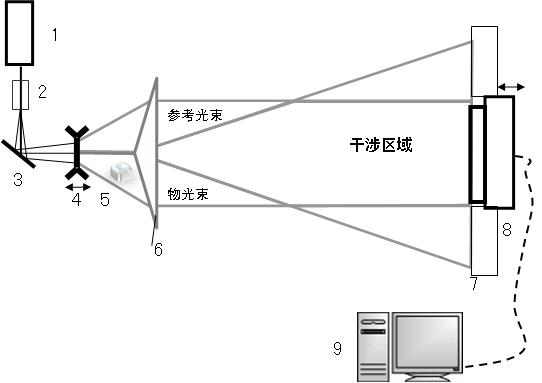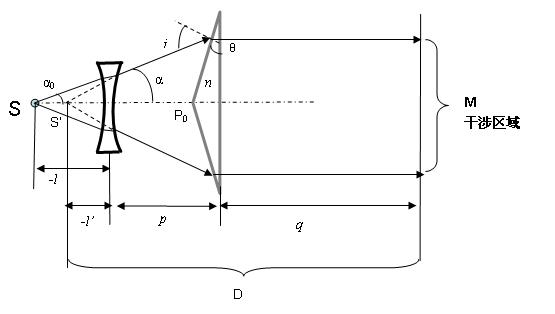Coaxial recording device for digital hologram of transparent substance based on beam-splitting property of Fresnel biprism
A Fresnel biprism, digital hologram technology, applied in the recording/reproducing/erasing, optical recording/reproducing/erasing methods using optical interference patterns, etc., to achieve good dynamics, simple structure, and deformation detection. Effect
- Summary
- Abstract
- Description
- Claims
- Application Information
AI Technical Summary
Problems solved by technology
Method used
Image
Examples
Embodiment 1
[0023] see figure 1 and figure 2 , the coaxial transparent material digital hologram recording device of Fresnel double prism light splitting, including a laser (1), a beam expander assembly (2-4), a Fresnel double prism (6), a CCD A camera (8), a baffle plate (7) and a computer (9), characterized in that the beam expander assembly (2-4) is set on the optical path of the beam emitted by the laser (1), The measured object (5) is placed in the optical path between the Fresnel prism (6) and the beam expansion period (2-4), and the CCD camera ( 8) Align the Fresnel double prism (6), set the baffle plate (7) around the CCD camera (8), and the CCD camera (8) is connected to the computer (9); the beam emitted by the laser passes through the beam expander assembly After (2-4), part of the light passes through the measured object (5), and then splits the light through the Fresnel biprism (6), the non-measurement beam is absorbed or blocked by the baffle plate (7), and the overlappin...
Embodiment 2
[0025] see figure 2 , the present embodiment is basically the same as the first embodiment and the special features are as follows:
[0026] The beam expander assembly (2-4) is composed of a mirror (3) arranged on the optical path behind the spatial filter (2), and a negative lens (4) is placed behind the mirror (3); the spatial filter (2) ) and the negative lens (4) play the role of beam expansion, wherein the negative lens (4) is required to be installed on the guide rail so that it can move along the optical axis; the function of the mirror (3) is to turn the beam direction to reduce the overall The transverse overall length dimension of the device.
[0027] The object to be measured (5) is a transparent object, placed between the negative lens (4) and the Fresnel biprism (5), and required to be within the space beam angle below the optical axis.
[0028] The refractive index of the Fresnel double prism (4) is , whose top angle The selection of the size needs to be s...
Embodiment 3
[0031] see figure 2 and 3 , this embodiment is the same as Embodiment 2, and its working principle is as follows: the light beam emitted by the laser (1) is focused at point S after passing through the spatial filter (2), and since the negative lens (4) has a diverging effect on the light beam, it passes through the negative lens (4). The converging point of the light beam after the projection lens (4) is S', that is, the light beam passing through the negative lens (4) can be regarded as being emitted through the point S'. Investigate the overlapping area (that is, the area received by the CCD camera (8)) of the two beams of light after the Fresnel double prism (6), and assume that the included angle of the Fresnel double prism (6) is θ , the refractive index of the prism is n , then the opening angle of the beam corresponding to the overlapping area is:
[0032] (1)
[0033] (2)
[0034] Su...
PUM
 Login to View More
Login to View More Abstract
Description
Claims
Application Information
 Login to View More
Login to View More - R&D
- Intellectual Property
- Life Sciences
- Materials
- Tech Scout
- Unparalleled Data Quality
- Higher Quality Content
- 60% Fewer Hallucinations
Browse by: Latest US Patents, China's latest patents, Technical Efficacy Thesaurus, Application Domain, Technology Topic, Popular Technical Reports.
© 2025 PatSnap. All rights reserved.Legal|Privacy policy|Modern Slavery Act Transparency Statement|Sitemap|About US| Contact US: help@patsnap.com



